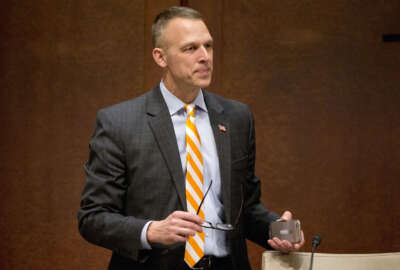
Can DHS get financial shared services right by following OMB’s refreshed strategy?
The administration plans to update its shared services strategy in the December release of the President’s Management Agenda.
Best listening experience is on Chrome, Firefox or Safari. Subscribe to Federal Drive’s daily audio interviews on Apple Podcasts or PodcastOne.
The Homeland Security Department laid out its plans in late October for a fourth attempt since 2003 to modernize its financial management system.
After failing twice with the private sector and once with a federal shared service provider, DHS told industry on Oct. 24 in a notice in FedBizOpps.gov that its market research revealed a two-pronged approach that may just work this time.
“At this point, the government plans to conduct two procurements for the Financial Procurement and Asset Management Systems (FPAMS): 1) software, and 2) system integration support services,” the notice states. “The government anticipates the award of the software procurement in June 2019. The government anticipates the award of the system integration support services in August 2019. The government expects to issue a draft statement of work, evaluation factors, and price schedule in December 2018.”
DHS’s decision to buy software and then integration support services isn’t surprising or unexpected. It is, however, a glimpse into the future of federal shared services.
When the Office of Management and Budget releases the December update to the President’s Management Agenda, the shared services cross-agency priority goal — Number 5 of 14 if you are keeping score at home — will have refreshed strategy.
Suzette Kent, the federal chief information officer, offered a small glimpse into what we should expect at the Nov. 1 Shared Service Summit sponsored by the Association of Government Accountants, ACT-IAC and the Shared Services Leadership Coalition.
“The way that we are going about the journey is in three pieces. The first is we are looking at services that are already fairly widely used and there is a lot of agreement. Maybe some of those are smaller services … like fleet management. We will be elevating those to the model that matches the target state of how the services are provided, which includes a focus on continuous innovation, a priority for customer service and shows ways we can get some quick wins,” she said. “The second thing we are focusing on are in areas [such as human resources or financial management] where we are driving out the standards and defining the journey around that set of solutions.”
Kent said that could mean coming to agreement across the government on the standards and then move out for quick wins in those areas.
Continuous innovation necessary
Finally, the third piece of the strategy is continuous innovation.
“Some of the barriers in the past have been once a service is rolled out that connection to continued improvement, leveraging new technologies, changing the operating model, continuing to build, grow and identify other services, that is a commitment we have to make,” Kent said. “It’s that ongoing commitment that we just don’t get to a place and stop, and get to that place and it’s just a starting point in the journey. And the agency is continually involved in defining new requirements, enhancements and leveraging those innovations so we continue to drive value, benefit and use modern technology.”
Kent said the refreshed strategy helps meet agencies where they are, but gives them an idea of what success looks like today and in the future. The administration is focused on 14 areas that it believes are ripe for shared services and which could save the government $2 billion over the next decade.
Other near term shared services opportunities for shared service that are emerging are around contract close-out and records management.
Latest Technology News
Beth Angerman, the acting principal deputy associate administrator in the Office of Governmentwide Policy at the General Services Administration and executive director of the Unified Shared Services Management office, put a finer point on the forthcoming update.
She said the PMA CAP goal for shared services includes 10 goals, including the requirement for agencies to participate in the development of standards so agencies can have a big say in what the future capabilities will be for HR or financial management or any area where shared services could work.
One size doesn’t fit all for shared systems
Another one is an acknowledgement that the government doesn’t need to build its own IT systems any more.
“There are commercial systems that exist that can help us drive better processes in government because those commercial solutions already have incorporated so many of those best practices that exist in industry,” she said at the summit. “The second one is one size doesn’t fit all. Hopefully, the new strategy really does give every agency the opportunity to declare some level of success, whether it’s through the participation of standards or through the adoption of existing services, and the goal will point out what those are, or whether it’s thinking through the plan to adopt new centralized services.”
The third piece to the strategy is competition is key and the government needs to be smarter buyer. Angerman said both of these factors came through clearly in the market research the USSM office did over the last year or so.
“That is the role you will see start to emerge for the service management offices to help us prevent the proliferation of instances, to help us make sure that we have smart contracts that give us the opportunity to bring innovation and to make sure we actually don’t have vendor lock-in,” she said. “All of the things that we’ve heard are the concerns of customers over time.”
There are plenty of examples over the last 15 years where these problems arose. Around too many instances, just look at the E-Travel program. GSA Administrator Emily Murphy said every agency uses the same travel management system, but each has a different version totaling more than 40 across government.
With vendor lock-in, the Labor Department’s experience shows why this has been a concern. Labor moved to a private sector provider for financial management services in 2010 only to have to buy back the software and the interfaces in 2014 for more than $20 million when the vendor went bankrupt.
And around innovation, the USSM office is emphasizing the “as-a-service” approach so agencies can buy services and not systems, which tended to be static while cloud services can be dynamic.
This brings us back to DHS and their seemingly never-ending effort to modernize their financial management systems. In its request for information from March, DHS wanted information on cloud and non-cloud systems. It wanted to know about application programming interfaces (APIs) and it wanted to know how the software is or plans to use artificial intelligence, blockchain and/or robotics process automation.
If DHS writes the solicitation using the tenets of the administration’s new strategy, then there may be hope for it and many other agencies like it that shared services may actually gain some real traction this time. Over the last 15 years, beyond payroll services, there have been only a handful of success stories and too many failures.
“We are making it a little better every time the baton is passed [from one administration to another],” Angerman said. “We are excited about the future.”
Read more of the Reporter’s Notebook
Copyright © 2025 Federal News Network. All rights reserved. This website is not intended for users located within the European Economic Area.
Jason Miller is executive editor of Federal News Network and directs news coverage on the people, policy and programs of the federal government.
Follow @jmillerWFED
Related Stories

OMB details 14 cross-agency priority goals in unveiling new President’s Management Agenda

Stymied by risk, costs, shared services office crafts 4 ‘as-a-service’ approaches




